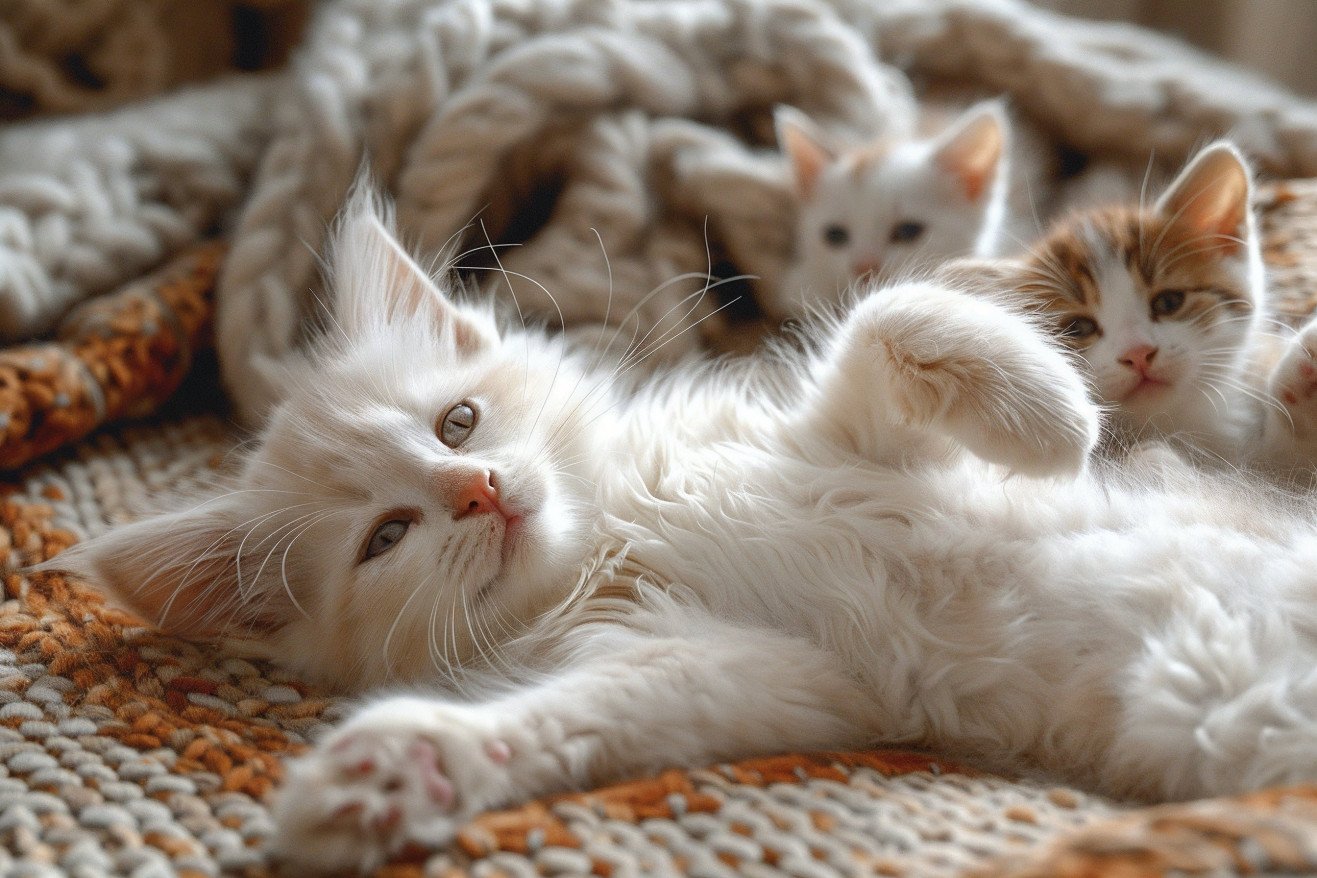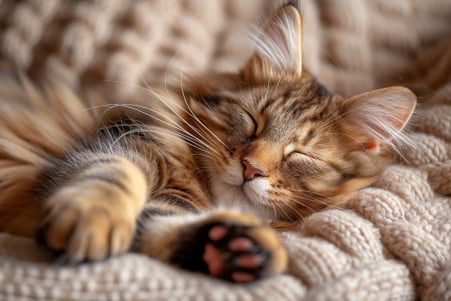How Many Nipples Do Cats Have? Uncovering Feline Anatomy Facts
10 February 2024 • Updated 10 February 2024

The anatomy of cats is full of surprises, not the least of which is the question of how many nipples cats have. The average number of nipples on a cat is six to eight, and they are located in two sets of parallel rows on the cat’s abdomen.
While the number of nipples can vary, the average number of nipples is the same in both male and female cats and is not dependent on the cat’s breed or size.
In this deeper look at the number of nipples on cats, we investigate the biological factors that determine this aspect of feline anatomy. Drawing on information from veterinary medicine, genetics, and evolutionary biology, we hope to present a complete picture.
This investigation is intended to help pet owners better understand the physical characteristics of their feline friends, including the factors that determine the number of nipples and how that number may impact a cat’s health and growth.
How many nipples do cats have?
The Complex Origins of Cat Nipples
During embryogenesis, cat nipples emerge from mammary lines, which then develop into placodes, the forerunners of mammary glands. According to a 2023 article by Hansen et al. in Breast Cancer Research, branching morphogenesis is a crucial step in forming the complex ductal systems necessary for lactation in mammals, including cats.
Hormones are also important; estrogen and progesterone are responsible for the growth and refinement of the developing glands. Estrogen is responsible for the initial development of the mammary glands, while progesterone is responsible for the branching that determines the number of nipples a cat will have.
A review in Pediatric Research also notes that genetic regulation is important in branching morphogenesis. Many genes work together to control mammary branching, which determines not only the number of nipples but also their location.
This basic knowledge of mammary gland development goes beyond academic interest; it has clinical applications in feline medicine. By understanding the roles of hormones and genetics in mammary gland development, researchers and clinicians can better understand and treat conditions like mammary tumors, which are regulated by the same biological pathways that control normal breast tissue development.
Knowledge of these developmental processes also helps explain the normal number of nipples in cats, which can help us better care for and understand these popular pets.
The Evolutionary Role of Cat Nipples
The number of mammary glands in mammals has evolved in tandem with litter size, indicating a coevolution that benefits the offspring.
In cats, the average number of nipples ensures there is enough milk for the average litter size, which in turn helps kittens survive and thrive.
As a study on bioRxiv explains, the number of mammary glands coevolves with litter size in mammals, following the so-called identity rule, in which the maximum reported litter size of a species tends to equal the number of mammary glands. This evolutionary pattern underscores the importance of nipples in directly impacting the reproductive success of species, including cats.
Moreover, as noted in sources like PMC, mammary glands have played a key role in the evolutionary success of mammals, with lactation providing nutritional and immunological benefits that go beyond nourishment.
The evolution of these glands may have had a major impact on the survival of offspring and even played a role in the evolution of primate intelligence. For cats, the evolutionary benefit of having a certain number of nipples may be to ensure that kittens get enough nutrition while minimizing the mother’s metabolic investment.
This understanding of mammary evolution underscores the importance of nipple number in the larger context of feline health and reproduction, leading us to think about how variations and anomalies in this trait may impact cat populations.
Understanding Variation in Nipple Numbers in Cat Breeds
In terms of variation in the number of nipples in specific cat breeds, the studies that have been done so far have not found any evidence of breed-specific differences outside the normal range of six to eight.
Although there is little evidence of breed-specific differences in nipple numbers, the studies mentioned above suggest that genetic factors may play a role in the variation in the number of nipples in cats. This has led to interest in the genetic factors that may be responsible for the variation in the number of nipples in cats.
For example, a study published in the Public Library of Science notes that the genetic models of feline mammary cancer are so similar to human breast cancer that they are used to study the latter. This indicates that the genetic factors that influence the development of the mammary glands and the number of nipples in cats are complex and may be similar to those in humans.
Variation in the number of nipples could have implications for the health and breeding of cats. For example, the number of mammary tumors in cats is high, and 90% of them are malignant. A review published in PMC notes that the development of mammary tumors in cats is influenced by genetic and environmental factors. Therefore, understanding the genetic factors that influence the number of nipples in cats could be important for breeding and health purposes.
It’s possible that environmental factors play a role in the development of these traits as well, but the evidence for this is currently limited. As the field of comparative oncology continues to compare cancer in cats and humans, the information that is learned from the studies may be used to develop better ways to prevent and treat cancer in both species, but this will require more research.
Nipple Health in Cats
Mammary gland issues in cats, including but not limited to, mastitis and tumors, can have a major impact on a cat’s overall health and the health of her kittens.
According to PetMD, mastitis, which is an inflammation of the mammary gland, is common in lactating or recently lactating mother cats and is often caused by a bacterial infection. In addition to the pain and discomfort the mother cat will experience, the redness and warmth that comes with mastitis can make it difficult for the mother to nurse her kittens, which can lead to stunted growth and even death.
Mammary tumors are even more dangerous. According to a paper published by PMC, inflammatory mammary carcinoma in cats is similar to aggressive breast cancer in other species and should be treated as such. While mastitis can be treated with antibiotics, tumors will require surgery. Both conditions can be diagnosed with blood work, biopsies, and cultures.
Vets recommend that cat owners regularly check their cat’s nipples and mammary glands for lumps, swelling, discharge, and other abnormalities. If any of these symptoms are present, the cat should be taken to the vet immediately.
In addition, spaying cats can help prevent mastitis, which is often associated with lactation. This is why it’s so important to be aware of these issues and to take steps to prevent them. This will help ensure that cats live long and healthy lives.
The Mystery of the Cat Nipple: A Review of Feline Mammary Gland Number
In the study of feline anatomy, it has been determined that the average cat has six to eight nipples, a number that is not only consistent across sexes but also uniform across breeds.
The result of a complicated dance between hormones and genetics during embryonic development, this is a number that is determined by the levels of estrogen and progesterone in the womb.
This number of nipples has evolved to be perfectly in tune with the average litter size, and it is a critical factor in the survival of kittens, ensuring that there is enough milk to go around and that the next generation is well cared for.
Much rarer, nipple abnormalities are a major medical issue that can impact nursing and even lead to conditions like mastitis and mammary tumors. This is a reminder of the importance of regular check-ups and a call for more research into the field of feline anatomy.
In summary, the study of cat nipples is about more than just the number of nipples a cat has; it is about the relationship between biology, evolution, and health. Continued research in this area has the potential to not only help us better understand cats but also other aspects of mammalian development and pathology.


